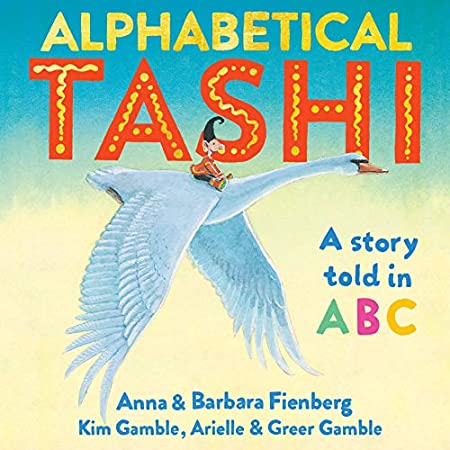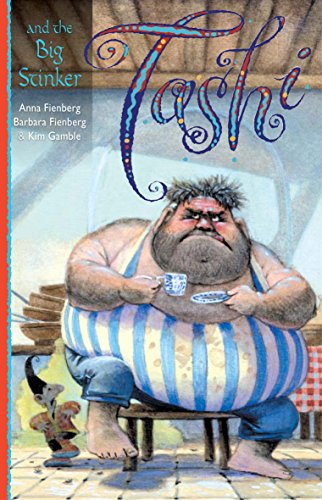Anna & Barbara Fienberg, Kim Gamble, Arielle and Greer Gamble, Alphabetical Tashi: A story told in ABC (Allen & Unwin 2020)
Anna Fienberg, Barbara Fienberg and Kim Gamble, Tashi (Allen & Unwin 1995, 2018)
Anna Fienberg, Barbara Fienberg and Kim Gamble, Tashi and the Big Stinker (Allen & Unwin 2000)
The Tashi books are a great success story of Australian children’s literature. They had their beginnings in stories that Barbara Fienberg told to her little daughter Anna in the bath. When Anna grew up to be a children’s author – editor of The School Magazine for some years, and creator of a string of picture books including The Magnificent Nose and Other Marvels – she and her mother decided to make some of those childhood stories into books. Kim Gamble, who had worked with Anna on a number of earlier projects, joined the project and created a charming and distinctive visual presence. Tashi was born.
Each of the Tashi books includes two stories told by Tashi to his friend Jack, who usually relays one of them to his father. Tashi comes from a land far away where he had amazing adventures and triumphed over aseemingly endless line-up of monsters and villains. There’s excellent comedy in the telling, as Jack’s father consistently exasperates his son by asking the wrong questions. Jack’s friendship with Tashi has a sweet, unforced subtext about the enriching possibilities of immigration.
Anna and Kim (full disclosure, I have worked with both of them and think of them as my friends) did magical school visits where Anna would read a story while Kim created a chalk image of one of its key moments. Many schools around New South Wales treasure the works created on those occasions.
So, how did Ruby, like many others of her age group obsessed with Elsa of Frozen, take to Tashi?
Not that well.
This gorgeous alphabet book was Ruby’s first encounter. After Kim’s untimely death in 2017, the Fienbergs and Kim’s daughters Arielle and Greer teamed up to make a kind of memorial using some of his original art created for the 16 books in the series.
We progress through the alphabet, as Tashi (A boy) confronts a series of foes, starting with Baba Yaga and ending with fierce Zeng and his army. Every page is striking and there are some spectacularly beautiful spreads featuring rural south-east Asian landscapes with karst mountains, ornate bridges, buffaloes and thatched roofs.
The verse narrative is sparse, and none of the encounters with baddies is spelled out in any detail. It’s meant to remind readers of past reading pleasures rather than provide new ones.
Ruby was generally unimpressed. She’s not interested in scary stories: she covers her ears during some bits of Catwings, or asks us to skip those pages altogether. So she took no pleasure in the wonderfully scary pages here. The one page that stirred her interest was V: ‘Very Big Stinker, who farted and fumed.’ This fitted very nicely with her current opinion that saying ‘Poo-poo’ is the height of wit.
So we bought a copy of Nº 7 in the series, Tashi and the Big Stinker, whose cover shows Tashi recoiling from a cloud of greenish gas at the rear of a very large man.
Oh dear! The farting pages were a long time coming and when they did they were far too graphic for our almost-four-year-old. The playing around with narrative point of view, which I have found delightful, went right over our young one’s head. And then the second episode, a dramatic retelling of the pied piper story, is far too scary for her: there’s a brilliant moment when all the children of the village are about to plunge over ‘a steep drop, down, down, a hundred metres down to the rushing waters of a mountain gorge’, led there by a pied piper figure who is as genuinely frightening as Heath Ledger’s Joker.
Perhaps we needed to go back to the beginning. We got hold of the original, Tashi, with an unstinky, elegant swan on the cover. But oh dear! The action that leads up to Tashi’s splendid flight on the swan had our little listener rigid with horror. Tashi’s parents sold him to raise money to travel. Never mind that they sold him to a war lord – we don’t care what that is, but we do care that parents can sell their children!
The second story in this book has a dragon – the last dragon – who, instead of turning into a good dragon which happens a lot in Ruby’s games, is killed by Tashi. Perhaps some of our extinction-averse zeitgeist has helped form Ruby’s sensibility. The fact that there is a benign grandmother was no help. Nor was the almost complete absence of female characters apart from her.
It was like introducing two dearly loved friends, only to have them take an instant dislike to each other, and being able to see why.
Maybe we’ll try again in a couple of years.
Tashi and the Big Stinker and Tashi are the 12th and 13th books I’ve read for the Australian Women Writers Challenge 2021.






I think the Tashi books in general are intended for a marginally older age range – more like 6. But it will be interesting to see what Ruby makes of them in a couple of years if you do give it a try then. They have clearly been very successful for a few reasons with young readers. The alphabet book is interesting because alphabet books are generally for younger children and yet, as you say, this one clearly assumes familiarity with the books, which are definitely directed at an older market.
LikeLiked by 1 person